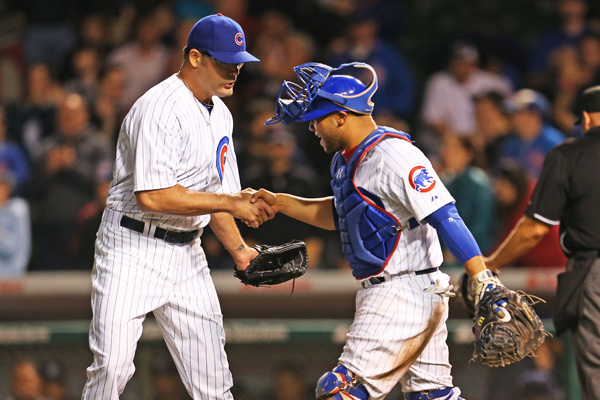
photo: Nuccio DiNuzzo / chicago tribune
Kevin Gregg and catcher Wellington Castillo after the last out against San Diego on Monday night.
Everyone in Chicago groaned when Kevin Gregg re-emerged as the Cubs' new bullpen stopper this season. The last time Chicagoans watched Gregg with any regularity, back in 2009, the bespectacled right-hander was losing his closer job to Carlos Marmol, and generally irritating a fanbase with a high threshold for irritation.
This season, since signing a minor league contract with the North Siders on April 14 and being promoted five days later, he’s actually been really good. Gregg has converted four saves in four chances, and hasn’t allowed a run in six appearances. On Monday night against the Padres, entering the game with two outs in the 8th inning and the tying runs on second and third, he got the third out, then retired three straight in the last frame to secure the team’s 10th win.
Before Tuesday night’s ugly affair, the Cubs relievers had posted a combined ERA of 1.03 since his call-up. Why has he been so good? “Calming presence," starter Jeff Samardzija told the Tribune. “He comes in, throws strikes and he pitches down in the zone.”
Those words are encouraging, to be sure, but strange to read. Elevated pitches are exactly what caused Gregg so much trouble during his first Wrigley stint four seasons ago. Before Gregg ever donned Cubbie blue, Beyond the Box Score expressed reservations about the trade that brought him in from Florida:
I have some questions about Gregg's 2009 performance as well. He has an impressive streak of four straight sub-4 FIP seasons under his belt, but I am concerned about his batted ball tendencies. Last year was the first time since 2005 that Gregg recorded more groundball outs than flyball outs. For his sake I hope he realizes how much more important this becomes as he moves from Dolphin Stadium (0.844 park factor for homeruns allowed) to Wrigley Field (1.163 park factor for homeruns allowed.) For a guy who saw a career low 4.4% of his flyballs become homeruns, I would get used to seeing quite a few more flying out of the ballpark.
It was a prescient warning. As the Cubs closer, Gregg threw a lot of high fastballs and change-ups, and he got burned badly by the long ball as a result. From 2008 to 2009, his fly ball rate jumped 9 points, and his HR/FB rate (the percentage of fly balls that leave the yard) skyrocketed from 4 to 15 percent, double his career average. In 68 innings of work, he gave up 13 dingers, more than any reliever that year. In August, during a two-week stretch with the Cubs in the playoff hunt, Gregg served up five home runs in four appearances. He lost his job on August 18, after yielding four runs in the ninth, on the way to a 4-1 defeat.
So what's changed? The sample size is tiny, but Gregg is taking a much different approach than Cubs fans are used to seeing, and it’s proving effective.
According to Fangraph’s PitchF/X data, he’s throwing far fewer fastballs than he did in 2009: 39 percent of pitches thrown, down from 61 percent. And when he mixes up speeds, Gregg is ditching his traditional change-up and curveball for a splitter and a sinker, two pitches that dive at the plate if thrown well. The latter is basically a new pitch; 25 percent of Gregg’s tosses have been sinkers this year, up from 6 percent in 2012 and just 2 percent in 2011. (He literally never threw one coming out of the Wrigley bullpen four years ago).
It’s biting hard, too. He’s thrown it 23 times so far, 16 for strikes, and he’s allowed zero batters to reach while striking out three. By keeping the ball down and locating his fastball, a trend Sveum credits for his early success, Gregg’s groundball rates have improved dramatically. If the white pill is rolling, it won’t fly into the Wrigley bleachers, and Gregg suddenly brings more value than a “near replacement bullpen arm.”
Speaking of home runs, Chicago profile subject Anthony Rizzo has hit a lot of them: eight in his first 27 games, fourth-most in the National League. He’s also hit comparably fewer line drives than he did in his rookie campaign, and struck out 28 times, a whiff rate that’s keeping a (loose) lid on his .225 batting average. Two weeks ago, Sveum made the rather ludicrous threat of demoting the Cubs slugger to the minors, but one would expect the youngster’s numbers to even out over the course of a full season.
In the blowout Tuesday night, Rizzo knocked out three doubles and a walk in five plate appearances, raising his season OPS by 60 points in the process. Cubs fans wouldn't mind seeing more highlights like that on a gigantic video scoreboard.


